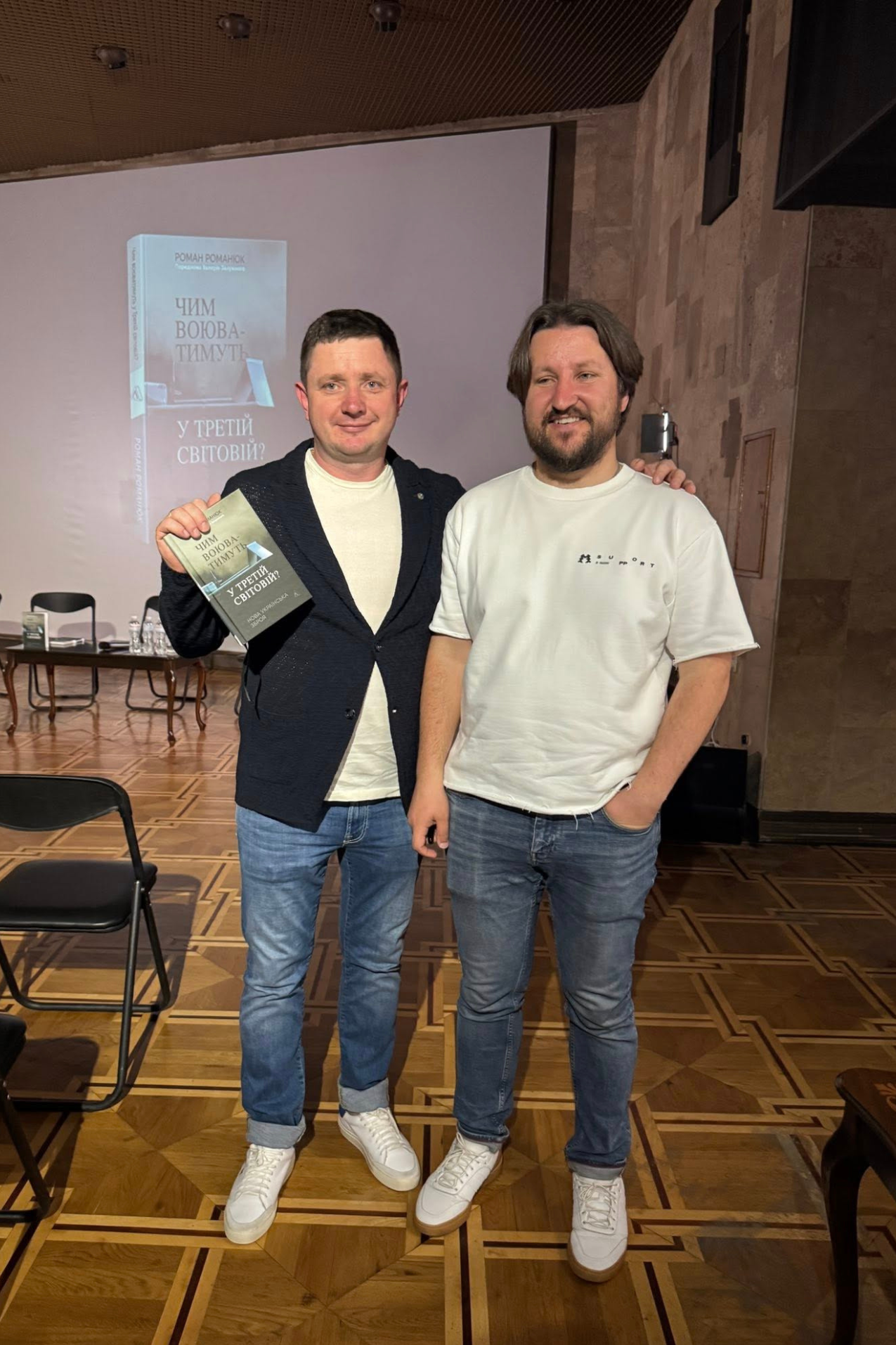Ario Law Firm Partner Yevhen Hrushovets Featured as a Hero in Roman Romanyuk’s Book, “What Will They Fight With in the Third World War? New Ukrainian Weapons”
News, Projects
Criminal Law and White Collar Crime
02 June 2025

The presentation of the book by Ukrainska Pravda journalist Roman Romanyuk, “What Will They Fight With in the Third World War? New Ukrainian Weapons,” took place recently. The book explores modern Ukrainian weaponry and its journey from concept to innovation. It serves as a documented chronicle of the Russian-Ukrainian war, featuring firsthand stories. Among the contributors is Ario Law Firm partner Yevhen Hrushovets, who took part in the operation to liberate Snake Island. He shares how the “Bohdana” self-propelled artillery forced Russian troops to flee the island.
The book also covers the creation of the “Neptune” missiles, kamikaze drones, “Baba Yaga” bombers, and other technical innovations that have shaped the course of the Russian-Ukrainian conflict.
“We have demonstrated what we’re capable of, even in a new kind of war. Ahead lies the formation of a fundamentally new doctrine of modern warfare. And it is on the battlefields of the Russian-Ukrainian conflict that this doctrine is already taking shape today,” writes Valerii Zaluzhnyi in the foreword.
“I’m honored that the chapter about the ‘Bohdana’ self-propelled artillery features an episode I participated in — the liberation of Snake Island. It’s a fascinating book that you can read in one breath. To sum it up, the author offers two key insights: ‘When the first chapters about “Neptune” and “Bohdana” were written, we hadn’t even dreamed of later chapters like “Baba Yaga” and “Lyutyi,”’” said Yevhen Hrushovets.
When asked about the most emotional chapter, the author responded that it’s probably the one about the ‘Bohdana,’ as it tells a story of something that should never have happened — the order to destroy the only existing “Bohdana” unit. It’s a story about Ukrainians doing the impossible. It’s heartening that even during wartime, we are writing and publishing books. Thank you very much, Roman Romanyuk!”
Passage from the book
“Monotonous Destruction”: Bayraktar in the Sky, Self-Propelled Guns on the Ground
Early in the morning—if not in the middle of the night—on June 17, following the described route with pontoons and newly built crossings, the BM-21 Grad launcher was the first to arrive at positions in the Danube wetlands.
Two days later, on June 19, the “Bohdana” self-propelled artillery unit made its first appearance on the front line.
The operation could have ended before it even began. But before sunrise, the “Caesar” was lifted, leveled, and moved onto solid ground. The “Bohdana,” which had also sunk slightly into the earth, managed to free itself thanks to its powerful engine.
However, the troubles of that day weren’t over. When the self-propelled guns finally reached their positions and fired their first shots toward Zmiinyi Island, artillery problems began to emerge.
After just three rounds, the “Bohdana” had burned out the barrel’s sealing rings. The “Caesar” broke down after its first 20 rounds when its lubricant started leaking.
The mission demanded constant strain from the equipment—both units had to operate at the absolute limits of their technical capabilities. But no one expected both to fail on the very first day.
While the crew debated how to send the units back for repairs and what to do next, the Russians were wide awake. On the very first day, enemy aviation struck the positions with several missiles. Fortunately, the strikes landed several kilometers away from the military personnel and border guards.
“Our command provided cover with a Buk system. We told them, you don’t have to shoot, but keep your radar on so the orcs see you’re here. But the Russians fired anyway. When we arrived at the impact site, there was a huge lake formed,” recalls Myroslav Hai.
After repairs, both self-propelled guns returned to their positions. However, the first shots presented an unexpected challenge: the spotters couldn’t see where the shells were landing.
It turned out that the “Caesar’s” shells detonated not on impact with the surface, but eight meters above it. This maximizes the spread of shrapnel and increases the area of effect. But when such a shell explodes over water, the explosion’s surface is barely visible.
Especially considering another issue—the distance. The island is located nearly 40 kilometers offshore. Approaching it at an optimal distance for observation was impossible.
The Matrix and Mavic drones used to monitor the island from shore couldn’t go far into the sea due to heavy Russian electronic warfare jamming. And the Bayraktar drone couldn’t provide a perfect image either—it wasn’t allowed to come closer than 28 to 30 kilometers to avoid entering the Russian air defense zone.
Therefore, targeting adjustments were made from two different locations: the shore team relied on their drones’ data, while generals in the “South” operational command headquarters monitored the Bayraktar feed and directed the strikes.
“If I see our image showing an explosion in the water in front of the island, it means it’s short. From shore, I understand if I need to move left or right. So, the Bayraktar hovered perpendicular to the island’s axis and adjusted fire by depth,” explains Hrushovets.
But before the operation began, proper coordination between the shore spotters and the headquarters hadn’t been established, so some “nuances” arose at first.
“We could see they were making mistakes, but the generals were sitting there giving commands like ‘plus 400 meters,’ while I could see clearly that wasn’t necessary. We fired—nothing, clearly overshot. At some point, I said: ‘Let me try firing according to what we see, under my responsibility.’ And then we started pounding!” Hrushovets recalls enthusiastically.
“You have to get a feel for how the Bohdana shoots. There has to be harmony between the spotter and the crew. We achieved that harmony,” he explains.
After the first days, the Bohdana got zeroed in, firmly “settled” on the ground, and at some point, the team realized they could adjust hits within about 20 meters on an island 40 kilometers away.
“It became especially easy once we took out the enemy’s radar and air defenses. They exploded beautifully and for a long time! Then we realized nothing was jamming the drone signals anymore,” says the Bohdana’s spotter.
From the very start, the team spread out artillery positions widely in the wetlands to avoid all being hit by a single strike. Also, the self-propelled guns fired alternately: the Caesar would fire a few rounds and then hide, followed by the Bohdana.
All shell and firing remnants were collected and hidden immediately to avoid revealing the base locations.
This continued for over a week, from June 21 to 30. After the air defenses on the island were destroyed, the Ukrainian-modified Grad multiple rocket launcher “Verba” joined in the assault on Russian forces.
On the “gesture of goodwill” day, June 30, only the Bohdana fired in the morning. Almost every shot hit Zmiinyi Island, making the Russian garrison’s presence there pointless.
“We fired 46 rounds. Each shell flew to the island for 90 seconds. But there had to be intervals to let the barrel cool down a bit. One after another, we sent the shells in this monotonous system of destruction,” recalls Hrushovets.
That morning, the team had 50 shells ready. The last four were kept in case the Russians brought reinforcements or an evacuation mission. When they did come to retrieve their garrison’s remains to Crimea, four powerful explosions followed.
From that moment, Russian control over the Ukrainian coast in that area was effectively lost.
A few weeks later, the “grain deal” was signed in Istanbul, where the Russian Federation effectively acknowledged it could no longer dictate terms in the Ukrainian part of the Black Sea.
One morning soon after, Ukrainian servicemen on duty witnessed an incredible sight: dozens of large dry cargo ships, like a flock of seagulls swooping down for bread, gathered between their positions and the island.
Heavy ships were sailing to the ports of Greater Odesa to pick up grain.

Chapters
Key partners
Related articles



